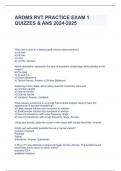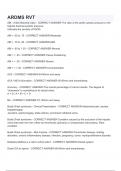Ardms rvt - Study guides, Class notes & Summaries
Looking for the best study guides, study notes and summaries about Ardms rvt? On this page you'll find 159 study documents about Ardms rvt.
Page 2 out of 159 results
Sort by
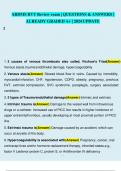
-
ARDMS RVT Review exam | QUESTIONS & ANSWERS | ALREADY GRADED A+ | 2024 UPDATE
- Exam (elaborations) • 14 pages • 2023
-
- $13.49
- + learn more
ARDMS RVT Review exam | QUESTIONS & ANSWERS | ALREADY GRADED A+ | 2024 UPDATE 1 1. 3 causes of venous thrombosis also called, Virchow's Triad(Answer) Venous stasis,trauma/endothelial damage, hypercoagulability 2. Venous stasis(Answer) Slowed blood flow in veins. Caused by immobility, myocardial infarction, CHF, hypotension, COPD, obesity, pregnancy, previous DVT, extrinsic compression, SVC syndrome, paraplegia, surgery associated conditions. 3. 2 types of Trauma/endothelial damage(Answ...
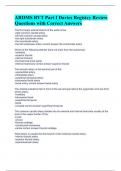
-
ARDMS RVT Part I Davies Registry Review Questions with Correct Answers
- Exam (elaborations) • 13 pages • 2024
- Available in package deal
-
- $12.99
- + learn more
The first major arterial branch of the aorta is the: -right common carotid artery -the left common carotid artery -the right subclavian artery -the innominate artery -the left subclavian artery correct answer the innominate artery Which of the following arteries does not arise from the subclavian: -vertebral -superior thyroid -internal thoracic -thyrocervical trunk (axis) -internal mammary correct answer superior thyroid The annular artery is the terminal pat of the: -supraorbit...
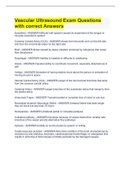
-
Davies ARDMS Vascular /RVT ARDMS Exam Bundle (Graded A) updated 2023
- Package deal • 13 items • 2023
-
- $28.49
- 1x sold
- + learn more
Vascular Ultrasound Exam Davies Vascular Flashcard Q&A Davie s Vascular Technology: An Illustrated Review - Part 1: Arterial Evaluation Vascular Prep ARRT ARDMS RVT Davies Vascular Technology Review VASCULAR ARDMS BOARDS DAVIES Exam Vascular Registry Review Ascular Sonography Combined Sets (RVT) Ultrasound Vascular Registry Ardms Abdomen Board
ARDMS RVT PRACTICE EXAM 1 QUIZZES & ANS

-
ARDMS RVT PRACTICE QUESTIONS AND ANSWERS
- Exam (elaborations) • 16 pages • 2023
-
- $12.49
- + learn more
While performing an AUG during a venous Doppler, you notice a change of color from blue to red that lasts 4 seconds. This is most likely caused by: A. DVT B. venous reflux C. HTN D. none of the above - Answer- B Making sure you're scale is not inverted, the blue should indicate flow away from the transducer, which is NL venous flow. If flow is red, that means signal goes toward the transducer. While scanning the popliteal area, you notice a round, anechoic structure. This is most lik...
ARDMS RVT Actual Questions and Answers With Complete Solutions 100% Verified | WELL ILLUSTRATED | LATEST UPDATE 2024
ARDMS RVT 2024 Q & A
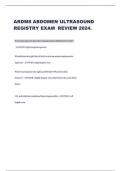
-
VASCULAR ARDMS BOARDS, ARDMS RVT Ultrasound Vascular Registry 2024 ( Latest)
- Package deal • 5 items • 2024
-
- $35.00
- + learn more
A package deal for all VASCULAR ARDMS BOARDS, ARDMS RVT Ultrasound Vascular Registry reviews and exams 2024. Download it ti have full access. Reach out to me for this and any other study materials or actual exams via email : e r i c k s m i t h 4 0 9 @ g m a i l . c o m
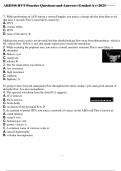
-
ARDMS RVT Practice Questions and Answers (Graded A+) 2023
- Exam (elaborations) • 17 pages • 2023
-
Available in package deal
-
- $13.99
- + learn more
ARDMS RVT Practice Questions and Answers (Graded A+) 2023 1. While performing an AUG during a venous Doppler, you notice a change of color from blue to red that lasts 4 seconds. This is most likely caused by: A. DVT B. venous reflux C. HTN D. none of the above: B Making sure you're scale is not inverted, the blue should indicate flow away from the transducer, which is NL venous flow. If flow is red, that means signal goes toward the transducer. 2. While scanning the popliteal area, ...
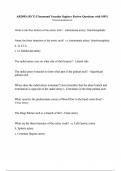
-
ARDMS - SPI, ARDMS Ultrasound Physics & Instrumentation, Pediatric ARDMS, OB/GYN ARDMS Registry, ARDMS BOARD and ARDMS RVT (ARDMS (RVT)) Exam | 2024 Questions & Answers | 100% Correct | Verified
- Package deal • 9 items • 2024
-
- $40.49
- + learn more
ARDMS - SPI, ARDMS Ultrasound Physics & Instrumentation, Pediatric ARDMS, OB/GYN ARDMS Registry, ARDMS BOARD and ARDMS RVT (ARDMS (RVT)) Exam | 2024 Questions & Answers | 100% Correct | Verified

$6.50 for your textbook summary multiplied by 100 fellow students... Do the math: that's a lot of money! Don't be a thief of your own wallet and start uploading yours now. Discover all about earning on Stuvia

